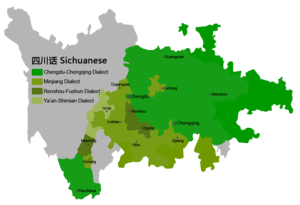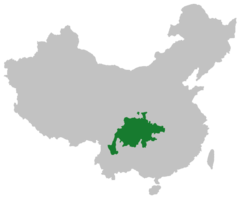Minjiang dialect
Minjiang dialect (simplified Chinese: 岷江话; traditional Chinese: 岷江話, local pronunciation: [min˨˩tɕiaŋ˥xa˨˨˦]; pinyin: Mínjiānghuà), is a branch of Sichuanese, spoken mainly in the Min River (Mínjiāng) valley or along the Yangtze in the southern and western parts of the Sichuan Basin. There is also a language island of Minjiang dialect located in the center of the Sichuan Basin covering several counties, including all of Xichong, Yanting, and Shehong Counties, and part of Jiange, Cangxi, Nanbu, Langzhong and Bazhong.
| Minjiang dialect | |
|---|---|
| 岷江话 | |
| Pronunciation | [min˨˩tɕiaŋ˥xa˨˨˦] |
| Native to | China |
| Region | Sichuan, Chongqing, Guizhou and Yunnan |
Native speakers | About 30 million |
Sino-Tibetan
| |
| Language codes | |
| ISO 639-3 | – |
cmn-xgm | |
| Glottolog | None |
 | |
The primary characteristic of the Minjiang dialect is that the stop consonants for checked-tone syllables in Middle Chinese have developed into tense vowels to create a phonemic contrast, and in several cities and counties the tense vowels retain a following glottal stop. It also keeps many characteristics of Ba-Shu Chinese phonology and vocabulary.[1][2] Due to these characteristics, the status of Minjiang dialect is disputed among linguists, with some classifying it as Southwestern Mandarin,[3] and others setting it apart as a successor of Ba-Shu Chinese.[4]
References
- 蓝勇 (1997). "第十三章:历史时期西南综合文化区的划分". 《西南历史文化地理》 (in Chinese). 西南师范大学出版社. ISBN 7-5621-1603-2.
- 刘晓南(2009年第8卷第6期),《试论宋代巴蜀方言与现代四川方言的关系——兼谈文献考证的一个重要功用:追寻失落的方言》,语言科学 (in Chinese)
- 李蓝(2009年第1期),《西南官话的分区(稿)》,方言 (in Chinese)
- 杨波(1997年第5期),《四川官话入声现象的历史文化透视》,西南师范大学学报(哲学社会科学版)
